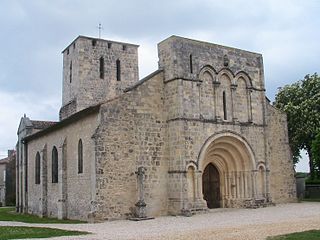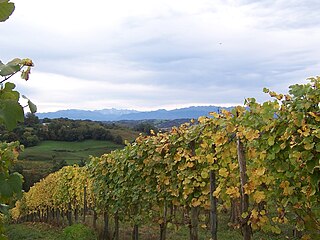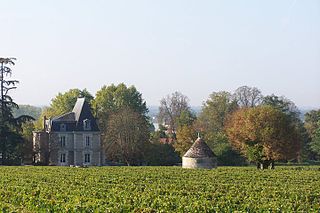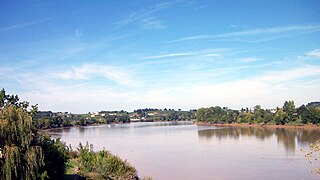
Saint-Émilion is a commune in the Gironde department in Nouvelle-Aquitaine in Southwestern France. In 2016, it had a population of 1,938.

Pomerol is a commune in the Gironde department in Nouvelle-Aquitaine near Bordeaux in southwestern France.

Barsac is a commune on the left bank of the Garonne river in the Gironde department in southwestern France.

Margaux is a former commune in the Gironde department in Nouvelle-Aquitaine in southwestern France. On 1 January 2017, it was merged into the new commune Margaux-Cantenac.

Saint-Estèphe is a commune in the Gironde department in Nouvelle-Aquitaine in southwestern France.

Moulis-en-Médoc is a commune in the Gironde department in Nouvelle-Aquitaine in southwestern France.

A Bordeaux wine is any wine produced in the Bordeaux region of southwest France. Bordeaux is centered on the city of Bordeaux, on the Garonne River. To the north of the city the Dordogne River joins the Garonne forming the broad estuary called the Gironde and covering the whole area of the Gironde department, with a total vineyard area of over 120,000 hectares, making it the largest wine growing area in France. Average vintages produce over 700 million bottles of Bordeaux wine, ranging from large quantities of everyday table wine, to some of the most expensive and prestigious wines in the world. The vast majority of wine produced in Bordeaux is red, with sweet white wines, dry whites, and rosé and sparkling wines collectively making up the remainder. Bordeaux wine is made by more than 8,500 producers or châteaux. There are 54 appellations of Bordeaux wine.

Capian is a commune in the Gironde department in Nouvelle-Aquitaine in southwestern France.

Libourne is a commune in the Gironde department in Nouvelle-Aquitaine in southwestern France. It is a sub-prefecture of the department.

Blaye is a commune and subprefecture in the Gironde department in Nouvelle-Aquitaine in southwestern France. For centuries, Blaye was a particularly convenient crossing point for those who came from the north and went to Bordeaux or further south, to Spain and Portugal. Fortified since antiquity, this eminently strategic site located on the bank of a large river, was not modernized until the end of the 17th century, thanks to Vauban. It is indeed in 1685 that the Commissaire general des fortifications of Louis XIV will propose the construction of a real lock on the Gironde in order to "take control of the river" and to keep Bordeaux in respect in case of a revolt. It is then that the citadel of Blaye will be built, which constitutes the major element of the estuary control system. Dominating the urban landscape, this imposing building has been listed as a UNESCO World Heritage Site since 2008, as part of the network of major sites in Vauban.

Saint-Sulpice-de-Faleyrens is a commune in the Gironde department in Nouvelle-Aquitaine in southwestern France.

The wine regions of Bordeaux are a large number of wine growing areas, differing widely in size and sometimes overlapping, which lie within the overarching wine region of Bordeaux, centred on the city of Bordeaux and covering the whole area of the Gironde department of Aquitaine.

Haut-Médoc is an Appellation d'Origine Contrôlée (AOC) for wine in the Bordeaux wine region of southwestern France, on the Left Bank of the Gironde estuary. Covering a large part of the viticultural strip of land along the Médoc peninsula, the zone covers approximately 60 kilometres (37 mi) of its length.

Cubzac-les-Ponts, also referred to as Cubzac, is a commune of the Gironde department in Nouvelle-Aquitaine, a region in southwestern France. Located 20 km southwest of Bordeaux, it is a crossing point of the river Dordogne. Cubzac has three bridges, one designed by Gustave Eiffel.

Puisseguin is a commune in the Gironde department in Nouvelle-Aquitaine in southwestern France. It is around 15 km east of Libourne.

South West France, or in French Sud-Ouest, is a wine region in France covering several wine-producing areas situated respectively inland from, and south of, the wine region of Bordeaux. These areas, which have a total of 16,000 hectares of vineyards, consist of several discontinuous wine "islands" throughout the Aquitaine region, and more or less to the west of the Midi-Pyrénées region.

Sainte-Croix-du-Mont is an Appellation d'origine contrôlée (AOC) for sweet white wine from the Bordeaux wine region in France.

Saint-Émilion is an appellation d'origine contrôlée (AOC) for wine in the Bordeaux wine region of France, where it is situated in the Libourne subregion on the right bank of the Dordogne. Saint-Émilion is registered as a World Heritage Site by UNESCO, the United Nations Educational, Scientific and Cultural Organization.

Ponty Vineyards, also known as Vignobles Ponty, is a wine estate of Bordeaux wine in the Canon Fronsac appellation located on the right bank of the Garonne river, 25 km away from Bordeaux, close to the city of Libourne. Close to the Pomerol and Saint-Emilion regions, Canon Fronsac’s landscape of plateaus and hills snuggle into the confluence of two rivers: the Isle and the Dordogne. Winemaking has been the family business for the Ponty family for more than five generations. The vineyard currently produces five wines: Chateau Grand Renouil, Chateau du Pavillon, Petit Renouil, Clos Virolle, and Blanc de Grand Renouil.

Fronsac is a wine growing region named after the commune of Fronsac on the right bank of the Gironde estuary in Bordeaux. It includes the following communes: La Rivière, St.-Germain-la-Rivière, St.-Aignan, Saillans, St.Michel-de-Fronsac, Galgon, and Fronsac. Canon Fronsac AOC is a sub-appellation contained entirely within Fronsac AOC in the southern area nearest the Dordogne river.
























